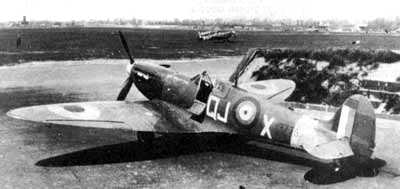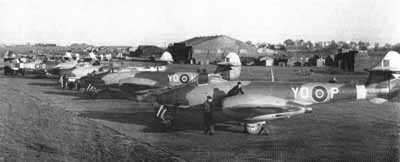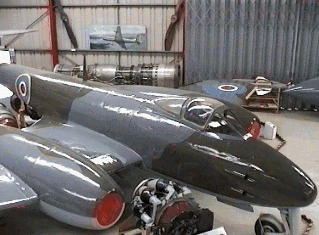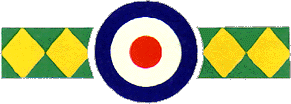616 (South Yorkshire) Squadron Royal Auxiliary Air Force.
Squadron
Motto -
|

|
616 Squadron was formed on November 1st 1938 at Doncaster airport as the last Squadron of the Royal Auxiliary Air Force. The Auxiliary Air Force was a part time force started to increase the strength of the regular Air Force. The first Squadrons were formed in the mid 1920's.
They were initially allocated as a light bomber squadron and received their first aircraft, six Hawker Hind's, on November 10th 1938. Two Avro Tutors and two Avro 504's were also provided for pilot training duties. However on November 15th 616 squadron was reallocated to Fighter command and by the end of January 1939 their Hind's were replaced with the, already outdated biplane, Gloster Gauntlet. Later in the summer of 1939 to give the pilots experience of monoplane aircraft the squadron received the four Fairey Battle, two single and two dual control.
The Squadron were on their first summer camp at Manston, where they were learning to work as a unit, when it was decided that the Auxiliary Air Force should be absorbed into the Royal Air Force. Thus 616 Squadron became a full-time squadron having to prepare themselves for War. They became part of 12 group and moved on October 12th 1939 to Leconfield. As a full member of Fighter Command they received their Supermarine Spitfire Mk 1.
A period of training now begun on the Spitfires to bring the squadron up to full battle readiness. The first flight was declared operational on January 11th 1940, the whole squadron becoming operational later in February. They were tasked with patrolling over shipping along the coast of the North Sea.
 |
The squadron had their first meeting with enemy aircraft when they were covering the Dunkirk Evacuations from May 26th to June 6th. They has been moved south to Rochford to become part of the Hornchurch Wing with 19 & 65 Squadrons. On May 28th while patrolling over Dunkirk with 19 and 65 Squadrons they were bounced by 30 Messerschmit Bf 109's. In the ensuing battle three Messerschmit's were shot down but the Spitfire of the CO Sqd Ldr Robinson was forced to crash land badly damaged by enemy fire. On June 1st three more were shot down and the Spitfire of plt Off Bell who was brought down in the sea to be picked up by the Navy. Later that day a group of bombers were attacked, one Ju88 being destroyed. Over the next few weeks back a Leconfield the squadron continued its operational flying punctuated with the intrusion of the odd Bomber. |
German Attacks began to increase in July with the start of the Battle of Britain. On August 12th the squadron was alerted to be ready to move south to the heart of the fighting although on the 15th Two large German bomber forces form Norway and Denmark were intercepted and broken up. 50 Ju88's were intercepted with 8 being shot down. This day, th 15th was Hitlers 'Adler Tag' or 'Eagle Day'. It was to be the day the Luftwaffe would launch the major offensive of the Battle of Britain that was to "... use all the forces at its disposal to destroy the british air force as quicly as possible...". However so cpmplete was the intelligence about the attack that in the north 616 contributed to a crushing defeat of the german Norway and Denmark Luftflotte. They would not launch such an attack again, merely being used for reconaissance role.
On the 19th 616 joined the Battle Of Britain in the south of England with 73 Squadron in 11 Group flying from Kenley. For just over 2 weeks the squadron was involved daily in the fighting which eventually took a heavy toll. On 3rd september 616 was rested from the main battle to RAF Coltishall being replaced by 66 squadron. Over half the squadron number had become casualties with 4 killed 5 injured and 1 prisoner of war. This period was very hard on 616 loosing some of its founding pilots. The squadron has aquitted itself well with 15 aircraft destroyed, six probables and nine damaged. The stay at Coltishall was to be short, allowing time to regroup the squadron and strengthen its numbers with newly qualified pilots and some experianced. A new CO was appointed Sqn Ldr 'Billy' Burton, and a young pilot arrived straight from training plt Off JE 'Johnny' Johnson who would play a great part in the second half of the War.
After only a few days the squadron return to its Lincolnshire home of Kirton-in-Lindsay, where it stay for the winter. Its new role was that of a training squadron for new pilots and a rest for those still involved in the fighting. The squadron found itself quickly back in the thick of the action with a detatchment flying south to Fowlmere on the 19th August to join in the Duxford 'Big Wing'. This contraversial formation was being advocated by Sqn Ldr Douglas Barder who was in 12 group just outside the main action of the battle.
Late Febuary of 1941 saw the squadron return to the fron lines when it moved to Tangmere and became part of the 'Tangmere wing'. It took over from 65 squadron and in the process took thier Spitfire Mk II's . Soon after their arrival Wg Cdr Douglas Barder took the newly appoined post of Wing Leader of Tangmere wing. He elected to lead the wing at the head of 616 Squadron, thus a perod renown in the history of 616 Squadron begun.
; sweeps Mk Vb Bader, Johnson Dundas West Macfie Lucas.....
616 were allocated the letters 'QJ' in April 1939. This resulted in a problem, as 92 Sqn were given the same code! It wasn't until 25 June 1941 that 616 were given the new code of 'YQ'.
High altitude Mk VI & Mk VII
~~~~
|
On July 12th 1944 616 Squadron became the first Squadron in the RAF, and that of the Allies, to become operational with Jet aircraft. They received the Gloster Meteor mk 1 which saw its first action on July 27th on 'anti-diver' patrols. The Germans had started using their 'Vengence' wepons soon after the D-Day 6th June 1944. The V1 Flying Bombs so called because when they were shot down they would suddenly dive into the ground out of control. They achieved great success claiming 10 destroyed in just 10 days, 13 was the final tally. |
 |
The first V1 Kill was by Flying Officer 'Dixie' Dean on 4th August 1944, he approached the diver only to have his guns fail Instead he drew alongside the diver and toppled it over using the wingtip of the Meteor under the divers wing. All the pilots were supposed to be taking great care of their aircraft as they were the only ones in existance. F/O Dean receved a repremand for this action as he damaged the wingtip of the Meteor
A detachment of four meteors were sent to Holland as a prelude to the squadron moving into the front line. They were painted all white so as to be easily seen by the friendly troops they flew over. The aim was to familiarize everyone to the sight and especially the sound of the new aircraft with no propeller, It was done to help prevent them being shot down by friendly fire.
When the rest of the squadron moved to Holland in 1945 they were immediately tasked with Ground Attack Missions however they did not get much opportunity because the war came to an end on 1945. In this short time they successfully destroyed a great many enemy convoy trucks, trains and aircraft on the ground.
The Meteors were very special aircraft. Their construction was in the same all metal tradition that the war had started but the massive innovation of the engines caused them to be banned from operating deep into enemy territory. The fear was that even at this late stage in the war a captured Meteor engine would provide the germans with sufficient information to copy the metals which were vital to the opertion and longevity of the jet engines.
Although the ME262 was being flown, in slowly increasing numbers, its engined would only last around 12 hours of flight before they were burnt out. The cumulative effect of the war, with massive Allied bombing efforst against German industry had left Germany without the raw materials.
The Squadron was disbanded on August 29th 1945, although the effect was not felt for a while as the Squadron was simply renumbered to 263 Squadron.
 |
Recruitment started again in June 1946 after 616 Squadron was reformed at Finningley near Doncaster on May 10th 1946 again as part of the Auxiliary Air Force. They were designated as a night fighter squadron and received Mosquito NF 30's although they were stripped of most of their valuable radar equipment. At this time the squadron received its first Navigators, previously all operational aircraft being single seat fighters. Mosquito's arrived in September of 1947 only for it to be redesignated a day fighter unit in 1948. This change of focus returned the Meteor to 616 this time the newer Meteor F3 with Rolls Royce Derwent Engines. |
616 Squadron were dealt the final blow when on 10 March 1957 they were disbanded at Worksop with the abolition of the Auxiliary Air Force.

Gloster Meteor F4 Midland Air Museum

Gloster Meteor F8 in 616 Sqn Markings Elvington Air Museum

616 Squadron fuselage Banner as applied to the Meteor F8 circa 1955